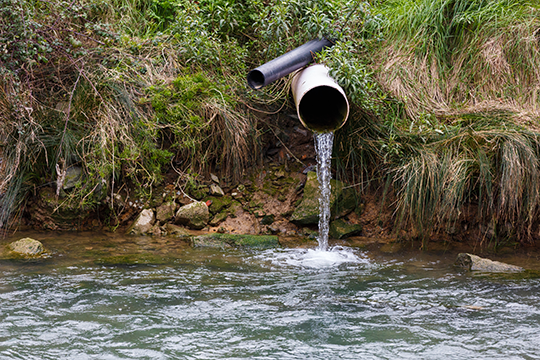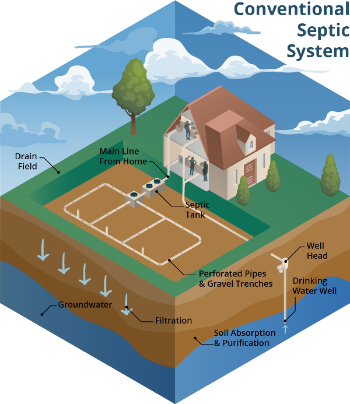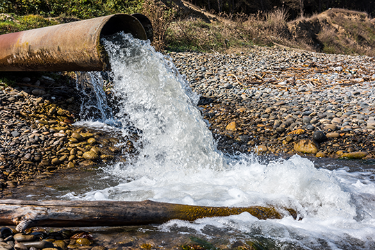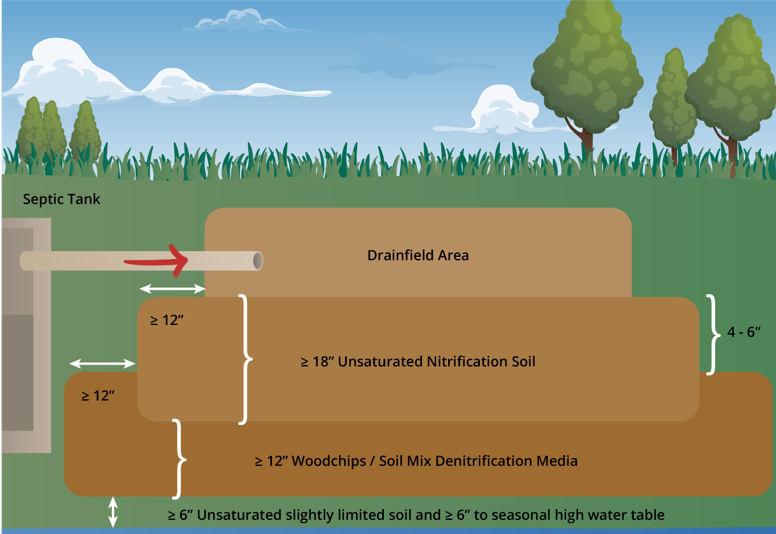Browse these frequently asked questions (FAQ) to discover details about septic systems, and how you can do your part in contributing to environmental preservation throughout Florida. Should you require further insight and information, please see our UF/IFAS Experts page.
-
Why is Excess Nitrogen a Concern?

Wastewater draining into waterway through municipal pipes | Getty Images
Nitrogen is one of the nutrients that fuels harmful algal blooms (HABs) and impairs the state’s water quality in both coastal and inland areas. Of Florida’s 30 first-magnitude springs (springs that discharge at least 100 cubic feet of water per second), 24 are negatively affected by excess nitrate-nitrogen. This is an inorganic form of nitrogen that is highly mobile in the environment, and readily available as a nutrient source to algae and other aquatic vegetation.
The Importance of Reducing Nitrogen Loads to Waterbodies
Nitrogen comes in both organic and inorganic forms. Plants and algae take up inorganic forms of nitrogen, such as ammonium (NH4) and nitrate (NO3). While most nitrogen in raw wastewater is in the organic form, bacteria under the low oxygen conditions in the septic tank convert organic nitrogen to ammonium. Once wastewater (or effluent) leaves the tank and flows into the drainfield, it is exposed to oxygen, and the ammonium is quickly converted to nitrate. Nitrate readily leaches through the soil into groundwater and other water bodies where it can lead to excess algal growth.
At high concentrations in groundwater (10 miligrams per liter or more), nitrate can cause health complications for humans (particularly infants) if ingested. It can interfere with the ability of blood to carry oxygen, leading to ‘Blue Baby Syndrome’ or infant methemoglobinemia. Because of this, it is important to test private well water for nitrate concentrations once a year.
Conventional septic systems were not designed to remove nitrogen. On average, they remove just 30 percent of nitrogen that enters the septic tank. Other sources of excess nitrogen affecting Florida’s ground and surface waters include urban and agricultural fertilizers, livestock waste, atmospheric deposition, and wastewater treatment facilities.
- Learn more about how septic systems work and how they treat nitrogen.
-
What’s Wrong with Conventional Septic Systems?

Modern residential septic system | UF/IFAS Photo
Nothing is inherently wrong with conventional septic systems. They have been widely used since the 1940s and were designed from a public health perspective to remove pathogens from wastewater. However, they were not designed to remove nutrients. As long as conventional septic systems are properly sited (placed in adequate soils with proper setbacks from the water table) and maintained, they do an excellent job in most instances of removing pathogens and protecting human health. However, on average they remove just 30 percent of the nitrogen that enters the septic tank.
There are advanced nitrogen removal technologies that can remove 50 to 80 percent of the nitrogen from residential wastewater. In Florida, nearly one in every three households depends on a septic system. The Florida Department of Health estimates more than 2.5 million systems are in use across the state.
-
Am I Required to Replace My Septic System?
 <
<
Cross-section of underground septic system | UF/IFAS Photo
Depending on where you live, you may be required to connect to sewer lines or replace/upgrade your existing septic system with one that includes nitrogen-removing technology. If septic systems are found to contribute a significant amount of nitrogen pollution to a spring (20 percent or more), the Florida Springs and Aquifer Protection Act mandates that local governments must adopt a remediation plan to address this source of nitrogen loading. These remediation plans may include conversion to central sewer when possible, or replacement/remediation of conventional septic systems with advanced nitrogen-removal features.
The Florida Springs and Aquifer Protection Act targets septic systems within the Priority Focus Area (PFA) of a nitrogen-impaired spring. PFAs are areas of the spring-shed (the area that contributes groundwater to a spring) where the aquifer is especially vulnerable to pollutant inputs because of factors such as geologic conditions, land use and nutrient loading, and proximity to the spring. All new septic systems on lots of less than one acre within a PFA must feature advanced nitrogen-removal technology. In addition, residents in a PFA may be mandated to upgrade to an advanced nitrogen removal treatment system if their conventional septic system requires repair or replacement.
Contact your local County Department of Health Office to find out if you live in a PFA or have questions about septic tank requirements, permitting and approved advanced nitrogen-treatment features for septic systems.
- Use FDEP’s interactive map to find out if you live in a PFA
- Learn more about FDOH product listings and approval requirements for advanced nitrogen removal technologies
-
What about Well-Maintained Septic Systems?
Septic systems were designed from a public health perspective to treat pathogens present in human waste. However, these systems were not equipped to remove excess nutrients. That means even a well-maintained system will become a source of nutrients (such as nitrate) that are introduced to the surrounding soil of the drainfield, and can leach into groundwater and surface waters. Conventional septic systems remove only about 30 percent of the nitrogen that flows into them. This nitrogen comes from human waste, as well as kitchen waste from the garbage disposal.
-
Which Advanced Nitrogen-Reducing Upgrades are Available for Septic Systems in Florida?

Septic system pump truck | Getty Images
Many enhanced nitrogen removal technologies exist, but only those approved by the Florida Department of Health (FDOH) can be installed in the state. Approved commercial options can be accessed through FDOH. Advanced treatment systems add steps to conventional septic system processes to improve contaminant removal. Types of advanced nitrogen removal technologies available include, but are not limited to:
Aerobic Treatment Units (ATUs)
The ATU is a sewage treatment system that replaces the septic tank, or is added after the septic tank of a conventional septic system. ATUs introduce air into the sewage and use an aerobic (high oxygen) process rather than the anaerobic (little to no oxygen) process used in conventional septic systems. By aerating (adding oxygen from air) waste, the treatment process rate is increased and many contaminants are reduced to levels considerably lower than from a conventional septic tank. Effluent from an ATU is discharged into a drainfield for further treatment in the soil, just as with a conventional septic tank system. ATUs usually refer to systems containing an aerator, but trickling or media filter technologies can also be included. ATUs require higher energy input than conventional septic systems to power the aerator or pumps and regular operation and maintenance to sustain performance.
- View a diagram of an ATU
- Learn more about maintenance dos and don’ts for ATUs
- Learn more about approved Nitrogen-Reducing ATUs for Springs Protection
Undeground view of septic system drainfield | UF/IFAS Photo
Performance-Based Treatment Systems (PBTS)
Performance-Based Treatment Systems (PBTS) are specialized systems designed by professional engineers to meet specific levels of contaminant removal based on site and/or situation requirements. There are many proprietary commercial options available. These systems are designed to reduce one or more contaminants such as total nitrogen (which includes nitrate), total phosphorus, fecal coliform bacteria, total suspended solids, and CBOD5 (carbonaceous biological oxygen demand). Designs often include an Aerobic Treatment Unit (ATU). Like ATUs, PBTS require higher energy input than conventional septic systems to power aerators and/or pumps and regular maintenance to sustain performance.
- Learn more about approved Nitrogen-Reducing PBTS for Springs Protection
In-Ground Nitrogen Removing Biofilters (INRBs)
In-Ground Nitrogen Removing Biofilters (INRBs) are also referred to as modified drainfields. These systems are passive, which means they require no electric aerators or pumps to treat wastewater and maintenance requirements are lower than those for ATUs and PBTS.
INRBs are nitrogen-reducing media layers placed underneath a conventional drainfield.
Ammonia-nitrogen (NH4) in wastewater leaving the septic tank moves down through the drainfield area soil and an additional oxygen-rich zone (unsaturated nitrification soil) to promote conversion into nitrate-nitrogen (NO3). It then passes through a low-oxygen (but carbon-rich) zone to promote denitrification (wood chips/soil mix denitrification media). Denitrification is a process by which specialized bacteria convert nitrate into nitrogen gas that escapes into the atmosphere. This prevents excess nitrogen from entering the groundwater and ultimately contaminating water bodies throughout the state.
-
Is Financial Assistance Available to Upgrade My Septic System?

Municipal pipe dumps wastewater into waterway | Getty Images
The Florida Department of Environmental Protection’s Septic Upgrade Incentive Program is designed to help homeowners upgrade or replace their existing septic systems through the addition of nitrogen-reducing technologies. This program provides certified septic tank contractors up to $10,000 in assistance to furnish homeowners with new or improved systems that feature nitrogen-reducing technologies.
Eligible homeowners include those living within the Priority Focus Area of an impaired spring in the following counties in Florida: Citrus, Hernando, Leon, Marion, Orange, Pasco, Seminole, Volusia, Wakulla.
The Priority Focus Area (PFA) of a nitrogen-impaired spring is the part of the springshed (the area that contributes groundwater to a spring) where the aquifer is especially vulnerable to pollutant inputs because of factors such as geologic conditions, land use and proximity to the spring.
- Use FDEP’s interactive map to find out if you live in a PFA
-
How Do I Get a Permit to Install, Repair or Abandon a Septic System?
Permitting and inspection of septic systems (also known as Onsite Sewage Treatment and Disposal Systems or OSTDS), is performed by the Environmental Health section of the Florida Department of Health in each county. For questions or concerns about septic system permitting and other issues, contact your specific county directly.
- Learn more about septic system permits and required forms
-
How Does UF/IFAS Spread the Word about Septic Systems?
UF/IFAS Extension agents have developed a toolbox of educational materials that can be used by both agents and local governments to educate homeowners about septic systems and their connections to water quality. In addition, homeowners with septic systems can learn more about how they can take advantage of the Septic Upgrade Incentive Program.


